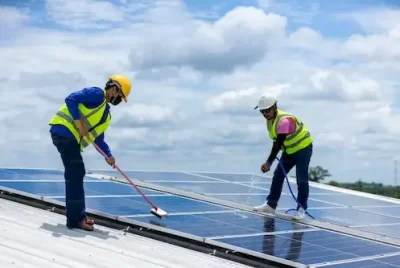Working Mechanism Of Solar Photovoltaic Power Plant
We may earn a commission for purchases made using our links. See our disclosure to learn more.
The technology to collect solar energy, which comes from the sun, has seen extraordinary improvement in recent decades, making it one of the most abundant and inexhaustible resources on Earth. Solar photovoltaic power plant has emerged as a leader among the many approaches of harnessing this renewable energy source. From collecting sunlight to producing power, this page covers the entire process in detail.
Solar Power Plants: An Overview
Large-scale systems that collect sunlight and turn it into electricity are known as solar power plants or solar parks. Solar power is gaining popularity as an alternative energy source since it does not degrade resources or cause harmful pollutants like fossil fuels do.
The photovoltaic (PV) cells used in solar photovoltaic power plant constitute the technology’s backbone. Organic photovoltaics cells are highly efficient in converting solar radiation into usable power. Solar panels are collections of PV cells, and solar arrays are collections of many such panels. The solar power plant consists of these arrays spread out over a broad area.
Energy Conversion Procedures in Solar Power Plants
Capturing Sunlight
Gathering solar energy is the first stage. The solar panels at the solar photovoltaic power plant are tilted at specific angles to capture the most sunlight possible. The panels’ protective glass coating also allows more light to get through, increasing the amount of solar energy harvested.
Light photons interact with the solar cell material (often silicon) or organic solar cells to create an electric current, which is the scientific basis for solar energy collection. In a PV cell, a positive-negative (P-N) junction is formed by doping the silicon. When light hits organic photovoltaics, it jars free electrons, which are then accelerated across the junction, generating a current.
Direct Current (DC) Generation
Direct current (DC) is produced by the flow of these electrons. One to two watts of electricity can be generated from a single cell. The output, however, can approach the megawatt range when hundreds or thousands of these cells are joined together in a panel, and when many panels form an array.
Conversion to Alternating Current (AC)
Direct current (DC) is the form in which solar-cell-generated power exists. However, we typically utilize AC, or alternating current, electricity in our homes and offices. So, the DC that is produced must be changed into AC. An inverter, a vital part of any solar power plant, does this. The inverter converts the direct current (DC) power from the solar array into alternating current (AC) power that can be used by standard household appliances.
Transformation to Suitable Voltage
Even after being transformed into AC, the DC power may still be too high in voltage for immediate usage. The power must be of the same voltage as the power grid. Transformers are useful in this context. They may adjust the AC power’s voltage up or down to meet the needs of the grid. After the voltage has been properly set, the power can be distributed.
Connection to the Grid and Distribution
Getting the power to consumers is the last phase. The generated electricity is fed into the regional electrical grid, which is made up of power plants, transformers, and power lines. The power can be used instantly or saved for later consumption.
Important Components of Solar Power Plants
Solar power plants aren’t just made up of solar panels and inverters; there are a variety of different parts that work together to keep the plant running smoothly and securely.
Mounting Structures
Solar panels require mounting structures to keep them in place. The elements, including wind, rain, and temperature swings, pose no problem for them because they are built to last. Panels can get the most out of the sun by following its path across the sky, which is possible with certain mounting configurations.
Charge Controllers
A charge controller regulates the flow of electricity into or out of batteries. The primary use of this feature is to protect the battery from being overcharged.
Batteries
Energy storage batteries are employed in many solar power facilities. This is especially crucial when sunshine is not available (at night or because of bad weather). When it’s needed, the stored energy can be released.
Monitoring and Metering Devices
Solar power plant efficiency, energy output, and other metrics may all be tracked with the use of monitoring equipment. In contrast, metering devices track how much energy is added to or taken from the grid.
Solar Power Plants: The Way Forward
As a result of technical advancements, solar power plants are now more effective while simultaneously experiencing a reduction in the expenses involved with operating them. Integration with other forms of renewable energy, incorporation into smart grids, and the development of novel materials for use in organic solar cells are all promising avenues for expansion in the field of solar power plants in the near future.
Solar power plants present a compelling argument for a supply of electricity that is abundant, sustainable, and derived from renewable sources. Solar photovoltaic power plant are well positioned to become a significant component of the energy landscape on a worldwide scale as more financing and attention is directed toward the solar energy industry.
In addition to their primary function of generating energy, solar power plants can be used to a variety of other uses. They provide a glimmer of optimism in the search for a future that is cleaner and greener, as well as a solution to our energy challenges that can be implemented over the long term.
Last but not least, in order to fully comprehend the potential that solar power holds for our energy future as well as the significant part that it will play, one must be familiar with the operating technique that is utilized by solar power plants. The power of human creativity is on full display at every step of the process, from capturing the sun’s rays to converting them into usable electricity. This highlights the need of making the most of the resources that mother nature provides.
Read more here: Solar Power Knowledge Hub




